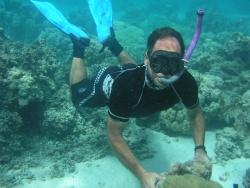IMS Affiliated Faculty

- Title
- Professor
- Division Physical & Biological Sciences Division
- Department
- Ecology & Evolutionary Biology Department
- Institute of Marine Sciences
- Affiliations Environmental Studies Department
- Phone 831-459-5674
- Fax 831-459-3383
- Website
- Office Location
- Long Marine Lab Ocean Health Building, Center for Ocean Heallth, Room 254B
- Office Hours by appointment
- Mail Stop Long Marine Lab
- Mailing Address
- Center for Ocean Health, Long Marine Lab, UC Santa Cruz
- Santa Cruz CA 95060
- Faculty Areas of Expertise Ecology, Evolution, Statistics
- Courses BIOE 108: Marine Ecology, BIOE 159: Marine Biology Field Quarter, BIOE 161: Kelp Forest Ecology, BIOE 158L: Marine Biology Laboratory, BIOE 286/L: Experimental Designa d Data Analysis
Summary of Expertise
Ecology and Evolutionary Biology of Marine Organisms
Statisitics
Experimental Design and analysis
Research Interests
Ecology and Evolutionary Biology of Marine Organisms
The goal of my research is to broadly understand the factors that are important in the development and maintenance of biological communities. To date I have worked in marine systems. In pursuit of that goal I use two methodological approaches. First, I have use field observations of populations and community structure and distributions to motivate specific and testable hypotheses concerning mechanisms affecting their development and maintenance. These hypotheses are then tested using short-term field (and sometimes lab) experiments. In addition, I have attempted to assess the generality of putative mechanisms by comparing community dynamics during the period of the experimentation with long-term community patterns. In recent years I have done considerable work addressing questions concerned with patterns, mechanisms and consequences of dispersal variability. In particular, I have worked with collaborators using Macrocystis pyrifera, giant kelp, as a model species. We have made considerable progress modeling dispersal and from projected patterns of dispersal predicting consequences resulting from variability in dispersal.
The second approach I have taken is to test hypotheses generated from theory (generally, analytical models) using field experiments. As one can see from my grant, publication and community service record I also do a fair bit of applied ecology. I view this as a responsibility of ecologists particularly those working in systems that are perturbed by anthropogenic impacts. Many undergraduates and graduate students are keenly interested in applied ecological problems and jobs, and through my work I am able to introduce them to the applied arena.
My current research interests include both basic and applied ecological problems:
The contribution of oceanographic forcing, propagule dispersal and post-settlement mechanisms to the development of benthic communities. This work has been funded by NSF, The David and Lucille Packard Foundation, The Gordon and Betty Moore Foundation and Minerals Management Service, Sea Grant among other funders.
Patterns, mechanisms and consequences of self-fertilization in organisms with short range dispersal and complex life histories. This work has been funded by NSF.
Mechanisms affecting stability of marine biological communities . This work has been funded by the The David and Lucille Packard Foundation, The Gordon and Betty Moore Foundation and Minerals Management Service Packard Foundation and UCMEXUS.
The importance of anthropogenic perturbations to community development and organization. This work has been funded by the State of California, NOAA and Minerals Management Service.
The patterns of social use and population structure of harvested species in the Gulf of California. This is a new Packard EBM grant that aims to determine the spatial coherence or lack of between local fisheries management (as practiced in the GOC) and population structure and connectivity of harvested species in the GOC.
In addition to these research themes I am also currently serving on advisory panels to the Federal Government (National Marine Sanctuary) State of California (California Fish and Game, California Coastal Commission, the Regional Water Quality Board and the California Energy Commission). My charge in is to oversee design and analyses of: 1) monitoring programs to detect impacts from the operation of existing and proposed new units at coastal power plants (Potrero, Moss Landing, Morro Bay, Diablo Canyon, Huntington Beach, and San Onofre from North to South) and 2) mitigation and monitoring programs required to compensate for impacts to the marine environment (Moss Landing, Morro Bay, Diablo Canyon and San Onofre). As an example we have designed possibly the largest complex marine field manipulation ever to look at reef designs to be used to mitigate for the loss of kelp resulting from the operation of San Onofre Nuclear Power Generating Station (SONGS). We have in place 7 blocks of 8 experimental reef designs, each of the 56 replicates is 40 x 40 meters. We are varying rock type (quarry or concrete) and percent cover (17, 34, 68% cover) and also include kelp transplants on a rock and concrete 34% cover plot at each block). The results of this experiment, have led to the recommendation that the mitigation reef (150 acres) be constructed of quarry rock of medium cover. In addition we are restoring 150 acres of wetland in this project to provide marine fish nursery habitat. Similar projects are being done at the other facilities.
Biography, Education and Training
B.A., Northern Arizona University
Ph.D., University of California, Santa Barbara
Post-Doc: University of California, Santa Barbara
